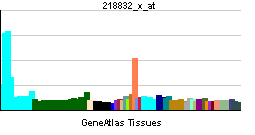Arrestin beta 1
| Arrestin, beta 1 | |||||||||||||
|---|---|---|---|---|---|---|---|---|---|---|---|---|---|
 PDB rendering based on 1g4m. | |||||||||||||
| |||||||||||||
| Identifiers | |||||||||||||
| Symbols | ARRB1 ; ARB1; ARR1 | ||||||||||||
| External IDs | Template:OMIM5 Template:MGI HomoloGene: 2981 | ||||||||||||
| |||||||||||||
| RNA expression pattern | |||||||||||||
 | |||||||||||||
| More reference expression data | |||||||||||||
| Orthologs | |||||||||||||
| Template:GNF Ortholog box | |||||||||||||
| Species | Human | Mouse | |||||||||||
| Entrez | n/a | n/a | |||||||||||
| Ensembl | n/a | n/a | |||||||||||
| UniProt | n/a | n/a | |||||||||||
| RefSeq (mRNA) | n/a | n/a | |||||||||||
| RefSeq (protein) | n/a | n/a | |||||||||||
| Location (UCSC) | n/a | n/a | |||||||||||
| PubMed search | n/a | n/a | |||||||||||
Arrestin, beta 1, also known as ARRB1, is a human gene.[1]
Members of arrestin/beta-arrestin protein family are thought to participate in agonist-mediated desensitization of G-protein-coupled receptors and cause specific dampening of cellular responses to stimuli such as hormones, neurotransmitters, or sensory signals. Arrestin beta 1 is a cytosolic protein and acts as a cofactor in the beta-adrenergic receptor kinase (BARK) mediated desensitization of beta-adrenergic receptors. Besides the central nervous system, it is expressed at high levels in peripheral blood leukocytes, and thus the BARK/beta-arrestin system is believed to play a major role in regulating receptor-mediated immune functions. Alternatively spliced transcripts encoding different isoforms of arrestin beta 1 have been described, however, their exact functions are not known.[2]
References
Further reading
- Lefkowitz RJ (1998). "G protein-coupled receptors. III. New roles for receptor kinases and beta-arrestins in receptor signaling and desensitization". J. Biol. Chem. 273 (30): 18677–80. PMID 9668034.
- Lohse MJ, Benovic JL, Codina J; et al. (1990). "beta-Arrestin: a protein that regulates beta-adrenergic receptor function". Science. 248 (4962): 1547–50. PMID 2163110.
- Calabrese G, Sallese M, Stornaiuolo A; et al. (1995). "Assignment of the beta-arrestin 1 gene (ARRB1) to human chromosome 11q13". Genomics. 24 (1): 169–71. doi:10.1006/geno.1994.1594. PMID 7896272.
- Parruti G, Peracchia F, Sallese M; et al. (1993). "Molecular analysis of human beta-arrestin-1: cloning, tissue distribution, and regulation of expression. Identification of two isoforms generated by alternative splicing". J. Biol. Chem. 268 (13): 9753–61. PMID 8486659.
- Iacovelli L, Franchetti R, Masini M, De Blasi A (1997). "GRK2 and beta-arrestin 1 as negative regulators of thyrotropin receptor-stimulated response". Mol. Endocrinol. 10 (9): 1138–46. PMID 8885248.
- Bonaldo MF, Lennon G, Soares MB (1997). "Normalization and subtraction: two approaches to facilitate gene discovery". Genome Res. 6 (9): 791–806. PMID 8889548.
- Goodman OB, Krupnick JG, Gurevich VV; et al. (1997). "Arrestin/clathrin interaction. Localization of the arrestin binding locus to the clathrin terminal domain". J. Biol. Chem. 272 (23): 15017–22. PMID 9169477.
- Lin FT, Krueger KM, Kendall HE; et al. (1998). "Clathrin-mediated endocytosis of the beta-adrenergic receptor is regulated by phosphorylation/dephosphorylation of beta-arrestin1". J. Biol. Chem. 272 (49): 31051–7. PMID 9388255.
- Aragay AM, Mellado M, Frade JM; et al. (1998). "Monocyte chemoattractant protein-1-induced CCR2B receptor desensitization mediated by the G protein-coupled receptor kinase 2". Proc. Natl. Acad. Sci. U.S.A. 95 (6): 2985–90. PMID 9501202.
- ter Haar E, Musacchio A, Harrison SC, Kirchhausen T (1998). "Atomic structure of clathrin: a beta propeller terminal domain joins an alpha zigzag linker". Cell. 95 (4): 563–73. PMID 9827808.
- Luttrell LM, Ferguson SS, Daaka Y; et al. (1999). "Beta-arrestin-dependent formation of beta2 adrenergic receptor-Src protein kinase complexes". Science. 283 (5402): 655–61. PMID 9924018.
- McDonald PH, Cote NL, Lin FT; et al. (1999). "Identification of NSF as a beta-arrestin1-binding protein. Implications for beta2-adrenergic receptor regulation". J. Biol. Chem. 274 (16): 10677–80. PMID 10196135.
- Lin FT, Miller WE, Luttrell LM, Lefkowitz RJ (1999). "Feedback regulation of beta-arrestin1 function by extracellular signal-regulated kinases". J. Biol. Chem. 274 (23): 15971–4. PMID 10347142.
- McConalogue K, Déry O, Lovett M; et al. (1999). "Substance P-induced trafficking of beta-arrestins. The role of beta-arrestins in endocytosis of the neurokinin-1 receptor". J. Biol. Chem. 274 (23): 16257–68. PMID 10347182.
- Miller WE, Maudsley S, Ahn S; et al. (2000). "beta-arrestin1 interacts with the catalytic domain of the tyrosine kinase c-SRC. Role of beta-arrestin1-dependent targeting of c-SRC in receptor endocytosis". J. Biol. Chem. 275 (15): 11312–9. PMID 10753943.
- Laporte SA, Oakley RH, Holt JA; et al. (2000). "The interaction of beta-arrestin with the AP-2 adaptor is required for the clustering of beta 2-adrenergic receptor into clathrin-coated pits". J. Biol. Chem. 275 (30): 23120–6. doi:10.1074/jbc.M002581200. PMID 10770944.
- Bennett TA, Maestas DC, Prossnitz ER (2000). "Arrestin binding to the G protein-coupled N-formyl peptide receptor is regulated by the conserved "DRY" sequence". J. Biol. Chem. 275 (32): 24590–4. doi:10.1074/jbc.C000314200. PMID 10823817.
- Shiina T, Kawasaki A, Nagao T, Kurose H (2000). "Interaction with beta-arrestin determines the difference in internalization behavor between beta1- and beta2-adrenergic receptors". J. Biol. Chem. 275 (37): 29082–90. doi:10.1074/jbc.M909757199. PMID 10862778.
- Barlic J, Andrews JD, Kelvin AA; et al. (2001). "Regulation of tyrosine kinase activation and granule release through beta-arrestin by CXCRI". Nat. Immunol. 1 (3): 227–33. doi:10.1038/79767. PMID 10973280.
| This protein-related article is a stub. You can help Wikipedia by expanding it. |